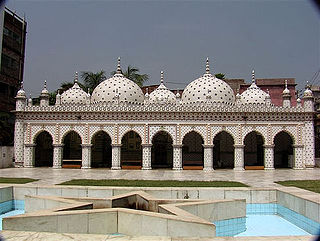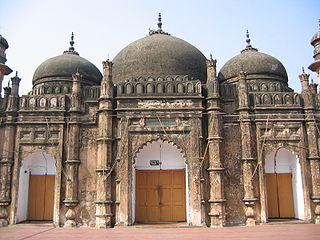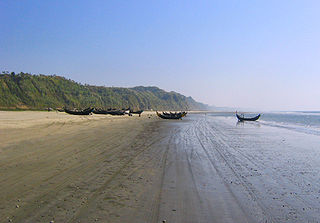
Dhaka College is the oldest educational institution of Bangladesh located in Dhaka. It offers higher secondary education (HSC). It has Honours and Masters programs as well which are affiliated to the University of Dhaka.

Star Mosque, is a mosque located in Armanitola area, Dhaka, Bangladesh. The mosque has ornate designs and is decorated with motifs of blue stars. It was built in the first half of the 19th century by Mirza Golam Pir.

Martyred Intellectuals Memorial is a built in memory of the martyred intellectuals of the Bangladesh Liberation War. The memorial is located at Rayerbazar, Mohammadpur Thana in Dhaka. The memorial was designed by architect Farid U Ahmed and Jami Al Shafi. The initial proposal for a memorial at Rayer Bazar was brought forward by Projonmo 71, who also laid a temporary foundation stone in 1991.

Shahbag or Shahbagh is a major neighbourhood and a police precinct or thana in Dhaka, the capital and largest city of Bangladesh. It is also a major public transport hub. It is a junction between two contrasting sections of the city—Old Dhaka and New Dhaka—which lie, respectively, to its south and north. Developed in the 17th century during Mughal rule in Bengal, when Old Dhaka was the provincial capital and a centre of the flourishing muslin industry, it came to neglect and decay in early 19th century. In the mid-19th century, the Shahbag area was developed as New Dhaka became a provincial centre of the British Raj, ending a century of decline brought on by the passing of Mughal rule.

Bara Katra, a historical and architectural monument, is one of the oldest buildings in Dhaka. The word Katra may have originated from Arabic word Katara which means colonnaded building. 'Katra/ katara' in Arabic and Persian means 'Caravan (Karwan) Sarai' or simply a 'Sarai'. It is a palatial building dating to the reign of the Mughal dynasty in the Bengal region. It is situated to the south of Chowk Bazaar close to the north bank of the river Buriganga.
Begumganj is an upazila of the Noakhali District in Bangladesh's Chittagong Division. Begumganj Thana, now an upazila, was established in 1892.
Sutrapur is a Thana of Dhaka District in the Division of Dhaka, Bangladesh.

The Khan Mohammad Mirza Mosque is a historical mosque near Lalbagh Fort in Dhaka, Bangladesh.

Chhota Katra is one of the two Katras built during Mughal's regime in Dhaka, Bangladesh. It was constructed in 1663 by Subahdar Shaista Khan. It is on Hakim Habibur Rahman lane on the bank of the Buriganga River. Basically it was built to accommodate some officials and Shaista Khan's expanding family. Chhota Katra is slightly smaller than Bara Katra, but similar in plan and it is about 185 metres east to it.

Bangladesh's tourist attractions include historical monuments, resorts, beaches, picnic spots, forests and tribal people, wildlife of various species. Activities for tourists include angling, water skiing, river cruising, hiking, rowing, yachting, and sea bathing.
Sonaimuri (সোনাইমুড়ী) is a newly established upazila or sub-district in Noakhali District, Bangladesh. It consists of ten union councils or parishads - Ambarnagar, Amisha Para, Bazra, Deoti, Jayag, Nadana, Nateshwar, Sonaimuri, Sonapur and Baragaon. Sonaimuri was declared as an upazila in response to a popular demand in 2005. The area of Sonaimuri is 169.14 km2 while its population is 327,194. People in this upazila is generally solvent and engaged in business and agriculture.

Northbrook Hall was originally built as a town hall during the British period. It is situated at Farashgonj road in Old Dhaka, Bangladesh, on the north bank of the Buriganga River.

The Sat Gambuj Mosque is near the northwestern outskirts of Dhaka in the Mohammadpur area. It is a fine example of the provincial Mughal style of architecture introduced in Bangladesh in the 17th century. The mosque's most notable features are its seven bulbous domes crowning the roof and covering the main prayer hall. Probably erected by Governor Shaista Khan, the monument stands in a romantic setting on a buttressed 15-foot-high bank overlooking an extensive flood plain.

The Dhanmondi Shahi Eidgah, also known as Mughal Eidgah, is located in Saat Masjid road, in Dhanmondi residential area of Dhaka, Bangladesh. The Eidgah was built in 1640 CE during the Mughal era and has been in use for Eid celebration since then.

The Armenian Church, also known as Armenian Apostolic Church of the Holy Resurrection, is a historically significant architectural monument situated in the Armanitola area of old Dhaka, Bangladesh. The church bears testimony to the existence of a significant Armenian community in the region in the 17th and 18th centuries.

The University of Dhaka is a public research university located in Dhaka, Bangladesh. It is the oldest university in Bangladesh. On the first day of July 1921, the university opened its doors to students. Today, it is the largest public research university in Bangladesh, with a student body of 37,018 and a faculty of 1,992. It was identified by AsiaWeek as one of the top 100 universities in Asia.

Kartalab Khan Mosque or Begum Bazar Mosque, in the Begum Bazar area in old Dhaka, Bangladesh, was built by Nawab Diwan Murshid Quli Khan in 1701–04. It is beside the modern jail of the city. The mosque consists of a high valuated platform, a mosque with a 'dochala' annex on the north upon the western half of the platform and a 'baoli' to the east of the platform. Unlike the three-domed mosques at Lalbagh Fort and the Khan Mohammad Mridha Mosque, it is roofed by five bulbous domes resting on octagonal drums. The whole mosque was once reconstructed by the Jamider of Dhaka, Mirza Golam Pir. In accordance with Murshid Quli Khan's wishes, he was buried under the entrance to this mosque.

Lalbagh Fort is an incomplete 17th-century Mughal fort complex that stands before the Buriganga River in the southwestern part of Dhaka, Bangladesh. The construction was started in 1678 AD by Mughal Subahdar Muhammad Azam Shah, who was a son of Emperor Aurangzeb and later emperor himself. His successor, Shaista Khan, did not continue the work, though he stayed in Dhaka up to 1688.
The following is a timeline of the history of the city of Dhaka, Bangladesh.

Atia Mosque is a four-domed mosque located in Bangladesh's Tangail District. It was built in the 17th century during the Mughal period and lies on the eastern banks of the Louhajang River. The country's Department of Archaeology has designated it as a protected monument.















